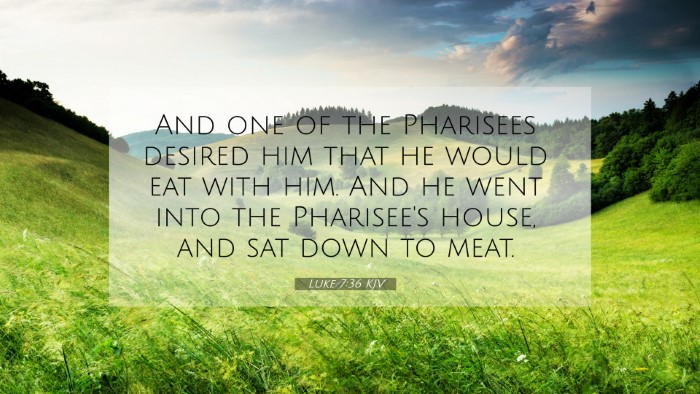Bible Verse Meaning: Luke 7:36
Luke 7:36 states: "And one of the Pharisees desired him that he would eat with him. And he went into the Pharisee's house, and sat down to meat." This passage sets the stage for a profound revelation of Jesus’ character and mission through the interaction with a Pharisee named Simon.
Summary of Insights
The encounter detailed in Luke 7:36 provides an opportunity for understanding both the cultural context of the time and the spiritual implications of Jesus’ actions and the responses of those around him.
Contextual Significance
Simon, a Pharisee, invites Jesus to his home, indicating a level of recognition and possibly curiosity about Jesus’ teachings. This act illuminates the connections between social status and spiritual insight in biblical narratives.
Insights from Commentaries
- Matthew Henry’s Commentary: Emphasizes the nature of Pharisees, who were strict observers of the Law, and how Simon's invitation indicates a wish to engage with Jesus, yet he still held preconceived notions about Him.
- Albert Barnes’ Notes: Observes the significance of Jesus accepting the invitation, noting that He often mingled with those in society who were typically marginalized, thus demonstrating His ministry to the lost.
- Adam Clarke’s Commentary: Highlights that Jesus’ willingness to dine with a Pharisee illustrates His mission to reach the lost, regardless of their social or religious status.
Thematic Connections
This verse connects to several Bible themes, such as:
- Grace and Forgiveness: The subsequent verses in Luke 7 show the sinful woman’s actions that reveal themes of repentance and forgiveness, deepening understanding of Jesus’ mission.
- Judgment and Hypocrisy: The Pharisees' reliance on their own righteousness contrasts with the openness and humility that Jesus encourages.
- Hospitality as a Tool for Ministry: The invitation to dine demonstrates the communal nature of Jesus' work and its implications for personal relationships in faith.
Bible Cross-References
Luke 7:36 is connected to numerous scriptures throughout the Bible that provide a fuller understanding of the themes introduced in this passage:
- Matthew 9:10-13: Jesus dines with tax collectors and sinners, further illustrating His mission to the marginalized.
- Luke 15:1-2: The Pharisees criticize Jesus for associating with sinners, echoing similar sentiments from Simon in our verse.
- John 3:17: “For God did not send his Son into the world to condemn the world, but to save the world through him.” This encapsulates the essence of Jesus’ mission highlighted in Luke 7:36.
- Matthew 23:23-24: Jesus rebukes the religious leaders for their hypocrisy, a theme closely related to Simon’s possible mindset.
- Luke 19:10: “For the Son of Man came to seek and to save the lost,” emphasizing Jesus’ outreach to sinners.
- 2 Samuel 9:7: David’s kindness to Mephibosheth parallels the grace Jesus extends to sinners.
- John 8:7: The verse, “Let him who is without sin among you be the first to throw a stone,” speaks to the themes of judgment and grace.
- Isaiah 61:1: Prophecy about the mission of Christ to bind the brokenhearted and proclaim liberty reflects Jesus’ approach in Luke 7.
- James 2:1: Warns against favoritism, linking to the societal divisions that Jesus challenges through His actions.
- Romans 5:8: “But God shows his love for us in that while we were still sinners, Christ died for us,” illustrating unparalleled love and acceptance.
Final Reflections
The interaction between Jesus and Simon allows for a broad examination of societal expectations of righteousness versus God’s grace. Through the lens of Luke 7:36, readers can explore the transformative power of Jesus' love and how it challenges established norms. This passage not only invites reflection on individual relationships with Jesus but also encourages deeper study into inter-Biblical dialogue, inviting believers to seek connections and cross-references that unite the whole of scripture.
Engaging with these insights through tools for Bible cross-referencing can be essential for anyone seeking to deepen their understanding of scripture and its interwoven themes. By utilizing a comprehensive Bible cross-reference system, one can enhance their study experiences, allowing for clearer identification of connections between not only gospel accounts but also to teachings found throughout the Old and New Testaments.
In conclusion, Luke 7:36 serves as a doorway for exploring grace, acceptance, and Jesus’ relational ministry as a reflection of God's love unfolded throughout scripture.








